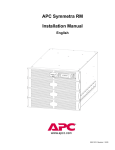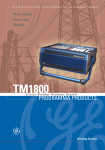Download APC 300 Power Supply User Manual
Transcript
User’s Manual APC Back-UPS® 300, 500, 650 Inspect Place 990-2004E Revision 7 12/99 Connect UPS to power Check site wiring fault indicator (rear panel-top) Inspect the UPS and its contents on receipt: • User’s Manual • UPS • Cord straps (2) • Telephone cable • Warranty card • APC Solutions magazine • Equipment Protection policy A lit indicator means that a shock hazard exists due to faulty building wiring , that should be corrected by a qualified electrician. 5 hours 500 and 650 VA models: Locate the UPS in a protected area that is free of excessive dust and has adequate air flow. Do not operate the UPS where the temperature and humidity is outside specifications. • PowerChute® plus software CD • Interface cable • Software Install Sheet If the building wiring fault indicator is lit, one of the following conditions exist: • Open or high resistance ground • Hot and neutral polarity reversal • Overloaded neutral circuit Connect the battery Refer to "Battery replacement procedure"- pg. 2 The packaging is recyclable, save it for re-use or dispose of it properly. Please fill out the warranty registration card to obtain warranty coverage. Note: Improper building wiring will not prevent the UPS from operating but will limit it's protection capability. Faulty building wiring could result in equipment damage that is not covered by APC. Please refer to APC's Equipment Protection Policy for details. Charge the battery The UPS battery charges whenever it is connected to utility power and typically requires less than five hours to charge fully. UPS capacity is reduced until the battery is fully charged. Connect equipment Accessory Surge Protection Outlets (500 and 650 VA models only): These outlets are for equipment that need surge protection but do not need power during a utility outage (like an inkjet printer or a scanner). BlockSafe™ Outlets (500 and 650 VA models only): Corded sockets are provided which accept "block type" plugs without covering other outlets. Some printers and external disk drives have block type plugs that look similar to the one below. Cord Straps: Straps are provided to keep cords from tangling and taking up too much space. Connect phone cables to surge protection (optional) Switch "On" and test the UPS Press the upper portion of the Power 1/0 switch and then switch "On" the equipment connected to the UPS. The Power 1/0 switch should be lit. Utility power is supplied to the equipment. Socket Location: Rear panel of 500 and 650 VA models only. Surge protection is provided for one phone line when it is connected as shown below: Perform a simulated utility blackout test to confirm the UPS unit can switch from utility power to battery power and back again, without affecting equipment powered by the UPS. Phone Line Connected equipment must be "On". Battery Back-Up Outlets: • • Surge protection when utility power is used Battery power and surge protection when utility voltage is outside acceptable limits. Data-sensitive equipment such as a computer, monitor, or external drive are connected to these outlets. Continued Start the test by either: • • Continued Caution: Do not connect a surge suppressor or laser printer to the UPS. These devices may overload the UPS. Unplugging the UPS power cord, or Pressing and holding the "Test" portion of the Test/ Alarm Disable switch (500 and 650 VA models only). Modem/Fax/Phone System 1. The UPS will then beep once every five seconds (or continuously) to remind you that your equipment is powered by a limited capacity power source. 2. Restore power to the UPS by releasing the Test switch or by reconnecting the UPS power cord. If the equipment operation was undisturbed throughout the testing, the system is operating properly. Connect computer interface cable (optional) Connect the interface cable to the computer interface port on the rear panel of the UPS. Connect the other cable end to an unused serial port socket on the computer and install the PowerChute® plus software (see software documentation for detailed instructions). Socket Location: Rear panel of UPS Note: 300 VA model users must purchase software and cable separately. Call APC at the number listed at the bottom of Page 2, and ask for software kit AP9015. UPS Controls Power 1/0 Switch 1 The UPS operates and all connected devices are powered. 0 The UPS is de-energized and all devices connected to battery backup outlets are unpowered The Power 1/0 Switch controls power to the UPS. Test/Alarm Disable Switch Test Switch Location: Front panel of 500 and 650 VA models only. Press the "Test" portion of the Test/Alarm Disable Switch to simulate a power outage - the UPS battery supplies power to the equipment All devices connected to battery back-up outlets can be switched "On" or "Off" using this switch, if each device's power switch is left in the "On" position. Lamp: The lamp in the Power 1/0 Switch is lit whenever normal utility voltages are present at the power sockets. Note: Accessory surge protected outlets are unaffected by this switch - they remain powered as long as utility power is available. Specifications The UPS will emit a beep once every five seconds during a utility power outage, unless the alarm is disabled by pressing this side of the switch. The UPS low battery warning (a loud continuous tone) will still sound in the event of an extended utility outage. The battery run time can be checked by pressing and holding the "Test" switch and waiting to see how long the UPS provides power to the equipment before the low battery warning is sounded. RunTime (minutes) vs. Power Demand Acceptable Input Voltage 0 - 150 V ac, Single Phase Transfer Voltage 103 V ac (may be set lower) Output Voltage Alarm Disable 109-121 V ac System Description Demand (Watts) Back-UPS 300 Back-UPS 500 Back-UPS 650 Desktop 486 w/14" or 15" Monitor 105 16 22 37 110 14 20 34 Input Over Current Protection Resettable circuit breaker Frequency Limits (on line) 57 - 63 Hz (autosensing) Desktop/Mini Tower Pentium w/14 or 15" Monitor Transfer Time (blackout response time) 8 ms Desktop/Mini Tower Pentium w/17" Monitor 130 10 17 26 Desktop/Mini Tower Pentium II/Pentium Pro w/14 or 15" Monitor 130 10 17 26 Tower Pentium II/Pentium Pro w/14" or 15" Monitor 150 8 14 21 Tower Pentium w/17" Monitor 150 8 14 21 Desktop/Mini Tower Pentium II/Pentium Pro w/17" Monitor 150 8 14 21 Desktop/Mini Tower Pentium w/21" Monitor 170 6 12 17 Tower Pentium II/Pentium Pro w/17" Monitor 170 6 12 17 Desktop/Minitower K6 w/21" Monitor 180 6 10 15 Maximum Load On-batter y Output Voltage 300 VA - 180 W 500 VA - 330 W 650 VA - 400 W 115 V ac On-batter y Frequency 58-62 Hz unless synchronized to utility during brownout On-batter y Waveshape Stepped sine-wave Output Over Current Protection Batter y Type Typical Batter y Life Overcurrent and shor t-circuit protected, latching shutdown on overload Spill proof, maintenance free, sealed lead-acid 3 to 6 years, depending on number of discharge cycles and ambient temperature Typical Recharge Time 5 to 10 hours from total discharge Operating Temperature 32 to 104° F (0 to 40° C) Storage Temperature 5 to 113° F (-15 to 45° C) Tower Pentium w/21" Monitor 190 - 9 14 Operating and Storage Relative Humidity 0 to 95%, non-condensing Desktop/Mini Tower Pentium II/Pentium Pro w/21" Monitor 190 - 9 14 Tower Pentium II/Pentium Pro w/21" Monitor 210 - 7 11 Operating Elevation 0 to +10,000 ft (0 to +3,000 m) Storage Elevation 0 to +50,000 ft (0 to +15,000 m) Audible Noise at 3 ft (1 m) Size (H x W x D) <40 dBA 300 VA, 500 VA: 6.0" x 3.4" x 13.1" (15.1 x 8.6 x 33.3 cm) 650 VA: 6.6" x 4.7" x 14.2" (16.8 x 11.9 x 36.1 cm) Weight 300 VA 13.1 lb (6.0 kg) 500 VA 15.4 lb (7.0 kg) 650 VA 23.0 lb (10.5 kg) Shipping Weight 300 VA 15.7 lb (7.1 kg) 500 VA 18.0 lb (8.2 kg) 650 VA 26.5 lb (12.0 kg) Listing and Cer tifications EMI Verification Electromagnetic Immunity UL 1778, CSA 107.1, FCC par t 15 and par t 68 FCC Class B cer tified IEC 801-2, 801-3, 801-4 level IV, and 801-5 level III Note: These values are approximate. Batter y age, excessive use, and elevated operating temperature may fur ther decrease UPS runtime. More information can be found at http://www.apc.com/sizing. Option Switches Order replacement battery A set of 4 switches, located on the rear panel, can be used to change how the UPS operates. For typical applications, all switches are in the down position as shown below. The table below shows the APC part numbers for APC Back-UPS replacement battery cartridges (RBCs). Replacements can be ordered from local retailers, APC, or the APC website at http://www.apc.com. Switch 1 300 and 500 VA models RBC2 650 VA model RBC3 Battery replacement procedure Switch Position Result Normal Setting: The UPS beeps once ever y five seconds when the utility voltage has fallen outside acceptable limits. If switch #1 is set to the "On" position, the UPS audible utility failure alarm is defeated. This feature is convenient when brief power interruptions are common and the alarm becomes annoying. This procedure requires a coin or screwdriver. Note: Please read the cautions in the APC Safety Information Guide first! Battery replacement is a safe procedure, isolated from electrical hazards. You may leave the UPS connected to utility power and your equipment connected and "On" during this procedure. Note: Once the battery is disconnected, the loads are not protected from power outages. Regardless of the position of switch 1, the UPS will sound a loud continuous tone during low battery conditions. 1. Lay the UPS on its left side. Remove the two screws holding on the battery door and open the door. Switches #2 and #3 Note: It may be necessary to pull the battery door slightly outward or toward the front of the unit in order to open the door fully. Switches #2 and #3 set the utility voltage value (transfer voltage) at which the UPS will switch to battery power. If you know that your equipment will operate properly at any of the voltages less than 103 V shown in the table, you can change to the corresponding switch positions. Changing the transfer voltage is desirable when frequent line voltage excursions or line voltage distortion cause the UPS to use battery power too often. Switch Position Transfer Voltage 103 V AC Normal Setting 2. Grasp the white tab attached to the battery and gently pull the battery out. 3. Disconnect the two wires connecting the battery to the UPS. Loosen the wires by wiggling them while pulling straight back from the battery connector. 98 V AC 93 V AC 4. Connect the new battery in place of the old. 88 V AC Note: Small sparks at the battery connections are normal during connection. 5. Insert the new battery in the UPS. Carefully avoid pinching the wires. Switch #4 (500 and 650 VA models only) Switch Position Result 6. Close the battery compartment door and replace the screws. Normal Setting: Two minutes prior to shut down during an extended power outage, the UPS will sound the low battery warning and activate the low battery signal at the computer interface por t. 7. Spent batteries must be recycled. Deliver the battery to an appropriate recycling facility or ship it to the supplier in the new battery's packing material. See the new battery instructions for more information. Same behavior as "Normal" except the warning is issued five minutes before shutdown. Use this setting if you require more than two minutes to save files and close operations. Troubleshooting Storage Use the table below to solve minor UPS installation problems. Consult the APC web site or contact APC Technical Support Staff for assistance with complex UPS problems. Before storing, charge the UPS for at least 10 hours. Store the UPS covered and upright in a cool, dry location. Possible Cause Procedure UPS beeps about every five seconds Utility power outage. None. The UPS is protecting your equipment. Be prepared to properly exit applications and the operating system, and then power "Off" the system before the UPS is seriously discharged. None. The UPS is protecting your equipment. UPS operates on-battery although normal utility voltage exists UPS input circuit breaker "tripped". Reduce equipment power demand by unplugging equipment from the UPS. Reset the circuit breaker (on back of UPS) by pressing plunger back in. A brownout has occurred. The transfer voltage can be lowered by changing option switches 2 and 3 (see previous section). Note: If you decide to lower the transfer voltage make sure all devices connected to battery back up outlets will operate properly at this lower utility voltage. UPS will not turn "On" UPS is not connected to AC power supply. Check that the power cable from the UPS to the power supply is securely connected. UPS circuit breaker "tripped". Reduce the power demand on the UPS by unplugging equipment and reset the circuit breaker. Very low or no utility voltage. Check the AC power supply to the UPS with a table lamp. If the lamp is very dim, have the utility voltage checked. Battery is not connected properly. Storage Temperature Recharge Frequency Charging Duration 5 to 86oF (-15 to 30 o C) Ever y 6 Months 10 Hours 86 to 113oF (30 to 45o C) Ever y 3 Months 10 Hours Service UPS beeps occasionally Temporary utility outage or disturbance. Long term storage Note: If the UPS requires service, do not return it to the dealer! The following steps should be taken. 1. Consult the Troubleshooting section to eliminate common problems. 2. Verify that no circuit breakers are tripped. A tripped circuit breaker is the most common UPS problem! 3. If the problem persists, consult the APC Worldwide Web site (www.apc.com) or call customer service. • Record the model number of the UPS, the serial number, and the date purchased. Be prepared to troubleshoot the problem over the telephone with a technician If this is not successful, the technician will issue a Return Merchandise Authorization Number (RMA#) and a shipping address. • If the UPS is under warranty, repairs are free. If not, there is a repair charge. 4. Pack the UPS in its original packaging. If the original packing is not available, ask customer service about obtaining a new set. Pack the UPS properly to avoid damage in transit. Note: Never use Styrofoam™ beads for packaging. Damage sustained in transit is not covered under warranty (insuring the package for full value is recommended). 5. Write the RMA# on the outside of the package. 6. Return the UPS by insured, prepaid carrier to the address given to you by customer service. APC contact information Check the battery connections. Consult the Battery Replacement Procedure that shows how to access the battery. USA/Canada ………........…… M ex i c o … … … … . . . . . . . . … … . . Brazil …………….........…… Worldwide ……........……….… UPS does not provide expected backup time The UPS is overloaded. Unplug non-essential equipment, such as printers. The UPS battery is weak due to recent outage or is near the end of its service life. Charge the battery. Battery capacity decreases with frequent (or long) power outages or when operated at elevated temperatures. If the battery is near the end of its service life, consider replacing the battery. Warranty Customers may return their defective unit to APC for replacement or repair during the standard 2 year warranty period. APC's standard procedure will be to replace the original unit with a factory-reconditioned unit. Customers who must have the original unit back due to assigned asset tags and set depreciation schedules must declare such a need at first contact with APC Customer Service. APC will ship out the replacement unit once the defective unit has been received by the repair department. The customer pays for the shipping to APC, APC covers ground freight transportation costs back to the customer. Internet E-Mail http://www.apc.com [email protected] 1-800-800-4272 292-0253, 292-0255 0800-12-72-1 1-401-789-5735












